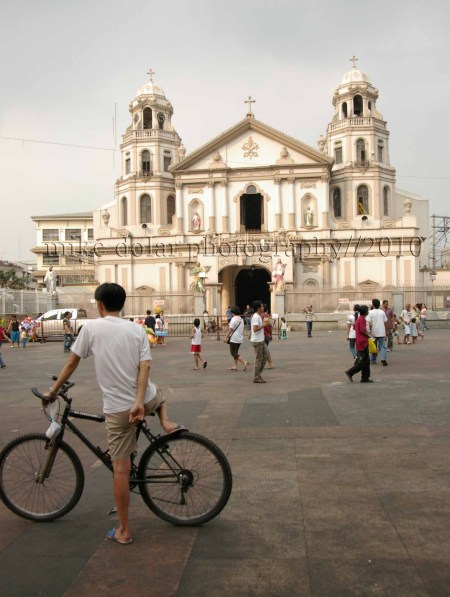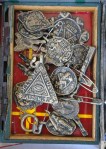
Metro Manila is supposedly enjoying the cool crisp morning weather of the earliest month of the year. Yet the swarm of men’s bodies is heating up the very environs of Quiapo, apparently the religious and cultural epicenter of Manila every 9th of January. During the Feast of the Black Nazarene, tens of thousands make their way to Quiapo Church and pay tribute to the image and what it represents for the miraculous wonders and bountiful blessings the Almighty has provided them through the years.
Quiapo Church, also known as the Parish of St. John the Baptist, is home to the most revered Jesus Christ incarnation here in Metro Manila. As the Philippines is a devout Catholic country, the intense and passionate adoration for the Black Nazarene, particularly during its feast is much palpable. The main roads and streets going to the church are closed to traffic by the Manila administration for the impending seeming madness of the devotees right at the thoroughfare. Ladies who garb themselves in crimson robes similar to that of the iconic image bearing the cross, wait patiently for the novena high mass, amidst the chaos. Men inch their way to the truck that brings the life size statue in a procession even through the narrow streets of Quiapo District. In the frenzied mob, each man tries hard to reach for the long and substantial rope hemp attached to the main truck, and participate as one among the many voyadores (men carrying the image). Every so often, as the truck transports the revered figure, hankies and towels are thrown to the main truck by the people, for the truck leader to pick up, wipe on the face or body of the Nazarene, and throw the cloth back to the crowd.
Although the feast day of the Nazarene is in early January, it is every Friday, whole year round, when devotees come to the church and mass in honor of the Black Nazarene. And it still becomes more crowded during Fridays. Yet almost everyday there are other happenings and things related to the spiritual and even supernatural within and outside the church of Quiapo.
Within the confines of the church, near the main entrance door, there are several women, usually seated in children’s plastic stools, deep in prayer many times. But many of these prayers are not for exactly for their own needs, but actually for those who have sought them for some spiritual intercession for specific intentions.
One such lady is Beth de la Cruz who does padasal (praying for an intention as a paid job service). It is an occupation passed down to her by her mother and grandmother many years back. She explains that there are some people who feel that their prayers are not enough for God to bestow positive responses. Some even seek her because people literally do not know how to pray and it would be a big relief for them if she can help out in asking the Father to grant them their wishes and requests. She says that the Quiapo church administrators and priests are aware of their existence, and it is only in Quiapo Church that such group is known to exist – asking prayerful intentions in behalf of others as a job.
Upon knowing one’s problems and concerns of the client, Beth writes down in a small notebook all the information needed such as the name of the person needing prayers and his circumstances lest she forgets what she will be imploring even days after. But then upon consultation, she gives a fast delivery albeit hushed, of a prayer in Tagalog. Then she opens her prayer book which focuses on the guidance of Padre Pio, the Capuchin Monk, popular for his stigmata (having the same wounds of Christ during his crucifixion) and miraculous healings. Then she prays again, intensely this time using the text from the prayerbook. At the end, she accepts some token money for the service rendered. The whole padasal event is quiet and should not even draw attention to those there, primarily for the masses. Thus it is wise to be discreet.
Outside the Church premises, there is a more conspicuous set of ladies and a few gentlemen who are offering help of a different kind. These are the famous and sometimes infamous manghuhulas (fortunetellers). They do all kinds of different ways of pointing out someone’s past and present, and offer to give out pieces of advice for the future. They huddle together in their makeshift consulting spaces consisting of a table and tiny chairs for themselves and their patrons. The clients listen intently as the seers whisper to them on what fortune can befall them.
In this area, Filipinos have sought counsel from the oracles on issues encompassing all facets of life -mundane or not. Middle aged ladies troop to the place to confirm about the suspected philandering husbands. Even business people seek opinion from fortunetellers on what enterprising endeavor is most profitable for them. And of course, the out of luck and out of job would ask if they could be more fortunate outside the Philippines. Or some rich lady would just like to know who the culprit is that stashed away her set of jewelry.
In such sessions, there are times that the socalled psychics are on point dishing out specific moments of past experiences, but largely the readings are too general to make a real impression. Therapeutic in a way, whether one gets to have a perceptive clairvoyant or not, let the client enjoy the ride, and take in the more positive comments to create a better person in him and probably, a better future ahead of him.
Many times, such seers will ask their clients to buy whatever concoction and medicinal remedies to ease out the problems, or to bring goodluck to their homes. But actually many of these preparations are also sold by the vendors surrounding the church premises. Herbal blends and brews are sold very cheaply. Some are offered as panacea to all physical ailments, but some have supposedly specific results to uncommon conditions, even of the bizarre kind such as house poltergeists, and possibly exorcism. In such places, one can even order a personal talisman that should protect a person from accidents and aggression.
Quiapo Church may be a famous landmark for first time foreign tourist, and even for nostalgic balikbayan (visiting or returning Filipinos from abroad). Probably, a novena mass on a Friday would be the highpoint of the visit. But it would be also interesting to explore the more mystifying attributes of the area, and perhaps enhance his fascination of this most valued place in the minds and the hearts of the Filipinos.
4 Things to Do in 4 Hours in Quiapo.
Quiapo has been synonymous to many spiritual exercises and religious rites. But one has to remember that this is a busy place too for business and commerce. And definitely one just has to scour some areas for cheap finds and discounted items. There is just a treasure trove of items to be had in this vicinity.
1. Commission a sastre (tailor) to produce a maong (denim) pants for you. Just go to the Quiapo Underpass near Isetann Mall at Recto Avenue. There is a variety of shades and textures of denim textiles to choose from. Quite inexpensive for a whole pants starting at P400 a pair. Can be chic too.
2. Get a new digital camera. Go to photographers’ haven at Hidalgo Street, near the Quiapo Church, and canvass the newest photo equipment, usually below the mall price cost. Cameras are brand new and original, but at grey market price thus they may not have explicit warranties.
3. Haggle with the vendors for intricately weaved baskets and embroidered tablecloths. Passby Ilalim ng Tulay (Under the Bridge) where all Filipino handicrafts are proudly displayed. A favorite haunt of Balikbayan tourists for souvenir items.
4. Sample the time honored Excellente Hams, near Quinta Market. Even if it is not Christmas time or New Year’s eve, why not bring some for pasalubong (homecoming treat) from Quiapo.













